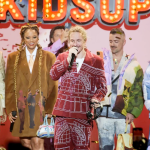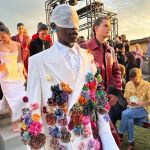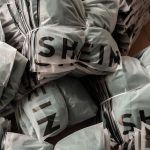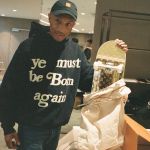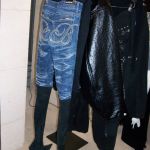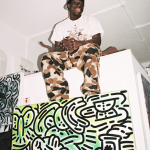
The history of the keffiyeh
From historical origins to catwalk appearances
June 13th, 2024
Whether on the streets of a European capital, on American university campuses, or on the red carpets of international events, among the pro-Palestinian protests around the world, a highly recognizable embroidery stands out in the crowd. A wave pattern, accompanied by a fishing net motif, and finally wider stripes. Since the beginning of the conflict between Israel and Hamas, the keffiyeh has become a symbol of solidarity with the Palestinian people. Evidence of how fashion can contribute to a global conversation beyond an aesthetic principle, it has transformed into a symbol of resistance, a visible testimony of free thought, and a reminder of genocide. Unfortunately, over the years, there have been attempts to distort its meaning: the keffiyeh has been labeled as a symbol of fear and hatred (in some schools in Germany, it has been banned because it is considered anti-Semitic), thus obscuring the historical roots of the headscarf.
The origins of the keffiyeh
Originally born as a traditional head covering for Arab farmers to protect themselves from the sun, it seems that the word itself, Keffiyeh, originated in Iraq, in the Iraqi city of Kufa, near Baghdad. The embroidery also seems to provide clues about its origins: some argue that it represents the fishermen's nets and the olive leaves of the Palestinian territories, while others believe that the leaves are those of the palm trees typical of the Iraqi lands. Despite the lack of a common narrative, the pattern assumed its current political connotation during the great Arab revolt of 1936 against the British mandate in Palestine. Among the crowd protesting against the mandatory power were fighters who used the keffiyeh to cover their faces, and it is reported that on August 27, 1938, they asked all Palestinian people to wear the headscarf to blend in with the crowd and maintain anonymity. In the late 1960s, following the Six-Day War, the Palestinian flag was banned in the Gaza Strip and the West Bank (a ban lifted only in 1993 with the Oslo Accords). The keffiyeh thus became an alternative, spreading worldwide as a symbol of Palestinian identity and culture. Its circulation was also aided by Palestinian political leader Yasser Arafat and a photograph of militant activist Leila Khaled. Taken by American photographer Eddie Adams, the image of Khaled wielding an AK-47 helped remove the keffiyeh from an exclusively male aesthetic, as explained by historian Nadim Damluji, and to encourage female participation in the Palestinian resistance worldwide.
The keffiyeh in pop culture and fashion

Balenciaga 2007-2008
In the 1970s and 1980s, the keffiyeh also became an anti-imperialist icon, worn by revolutionaries like Fidel Castro and Nelson Mandela. In the art world, it assumed an anti-authoritarian meaning, with Madonna wearing it in a 1982 photo shoot. After the Oslo Accords (but some say even before), the keffiyeh began to lose its political connotation in the Western world, becoming just another accessory. According to a survey from those years by the Palestinian Human Rights Campaign, only one in three people wore the keffiyeh for political reasons. The change was also represented in popular culture: in 2002, costume designer Patricia Field chose the pattern for Carrie Bradshaw in the fourth season of Sex and The City. It is unclear whether and how much Carrie was aware of its meaning, but Field certainly was, choosing the Michael and Hushi brand by Michael Sears and Hushi Mortezaie for the design. The duo had attracted media attention with their runway debut in 2001, showcasing a collection with Palestinian and Iranian iconography, as well as phrases like “The right to bear arms” and the famous red dress with a keffiyeh print.
If Sears and Mortezaie used the keffiyeh as a vehicle for debate and political provocation, others contributed to its downgrade to a mere accessory. One of the first was Raf Simons, who in the winter of 2001, made it the protagonist with the FW01 collection “Riot, Riot, Riot”—harshly defined as «terrorist chic». A few years later, in 2008, it was also proposed by Balenciaga under the direction of Nicolas Ghesquière and French designer Isabel Marant, making it one of the must-have accessories of the season. The popularity reached by the keffiyeh in the mid-2000s is comparable to that reached by the Che Guevara T-shirt, a symbol now stripped of its original political and revolutionary sentiment. In America and the UK, the keffiyeh became part of the offerings of mall brands, with Urban Outfitters producing it in various colors and renaming it as the “anti-war woven scarf”—a title that provoked a series of controversies until the removal of the item from the market—and TopShop with embroidery made of skulls (following the wave of Alexander McQueen's Skull Scarf), attracting a similar reaction.
The keffiyeh today
In 2008, journalist Rachel Shabi interviewed for The Guardian the Hirbawi family, the first and only owners of an authentic Palestinian keffiyeh factory in the city of Hebron. At the time, despite a high demand for Palestinian-patterned items in the Western market, the factory was at risk of closure. In conversation with Shabi, the family denounced the imports of fabric from China, which had become popular since the mid-1990s, and the major fashion brands that had turned the pattern into a luxury accessory. On one side there was Balenciaga with a keffiyeh on the market for 3,000 pounds, and on the other, there was the Hirbawi keffiyeh, sold for only 3 pounds. The fame of the black-and-white keffiyeh pattern in the fashion world sparked a still relevant debate on the authenticity of Western use and its cultural appropriation. The fashion brands that used the embroidery were accused of an unconscious and disrespectful attitude toward Palestinian culture. Among them was the French brand Louis Vuitton, which in 2021, under the creative direction of Virgil Abloh, presented a blue keffiyeh with the LV logo, on sale for 705 dollars. The Instagram profile Diet Prada reported it in relation to the supposedly neutral position of the maison's parent group, LVMH, criticizing the brand for contributing to the commercialization of the Palestinian headscarf.
Today, the keffiyeh has regained its original political and cultural connotation, especially among new generations of activists who use it as a symbol of solidarity and resistance. Last January, at Paris Fashion Week, the German brand GmbH closed the show with jackets featuring the same pattern. In an interview with Dazed, designers Serhat Isik and Benjamin Huseby stated they were not afraid to be political. «We are interested in the political and formal possibilities of fashion as a medium of intercultural exchange. As designers, we usually express our thoughts through clothing and leave the rest to the imagination. But we live in dangerous times where precision of words is necessary.» In Milan, the keffiyeh appeared on the runway of Salvatore Vignola, with a collection titled "If I Must Die", inspired by the poetry of Palestinian poet Refaat Alareer, killed in Gaza on December 7, 2023. Vignola donated the proceeds from sales to the Palestine Red Crescent Society, an organization that provides humanitarian aid in Palestine.
On the red carpet of the Cannes Film Festival, many celebrities showed solidarity with the Palestinian people. Jasmine Trinca wore a pin with the Palestinian flag, Cate Blanchett sported a dress with its colors, and Bella Hadid (who along with her sister Gigi donated one million dollars in support of Palestinian refugees) was seen wearing Michael and Hushi's red keffiyeh dress. At style events, as well as among street protests, there is a greater awareness of the headscarf's meaning, perhaps also thanks to the globalization of images through modern media. There is a growing desire to use the keffiyeh to represent a tangible connection with the struggle and resilience of the Palestinian people, and to declare an anti-colonial and anti-authoritarian stance, on the streets worldwide.










